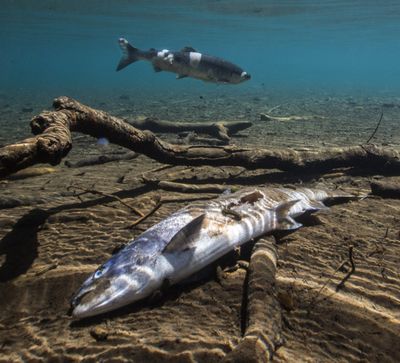Idaho wildlife managers to trap and truck sockeye to spare them exposure to too-warm waters

LEWISTON – The Idaho Department of Fish and Game will start trapping sockeye Tuesday at Lower Granite Dam and trucking the salmon to upstream hatcheries, where they will be held for spawning or release into Redfish Lake.
The extraordinary intervention in the upstream migration of the endangered fish aims to spare them exposure to hundreds of miles of dangerous water temperatures.
Last week the Army Corps of Engineers, at the behest of regional salmon managers, began releasing water from Dworshak Dam in an attempt to keep the Snake River at or below 68 degrees at Lower Granite Dam. Temperatures exceeding that threshold are considered dangerous to the fish, especially those that climb into the low to mid-70s.
Through the past four days of extreme heat, the water below the dam and others on the lower Snake River has hovered around the 68-degree threshold but temperatures have spiked in some fish ladders. Once the fish make it through the hydrosystem corridor and proceed upstream of Lewiston, conditions worsen. The fish leave behind the cool Dworshak water there, and this year must deal with low river flows that are being superheated by record high air temperatures.
“Earlier this week we looked at the temperatures in the Salmon River and the Snake River at Anatone, and they are well north of 70 degrees – 74 degrees, 76 degrees,” said Lance Hebdon, fisheries bureau chief for the Idaho Department of Fish and Game at Boise.
Jonathan Ebel, a fisheries biologist with the agency, said Salmon River flows at Shoup are about 25% of average, and water temperatures are as high as 76 degrees.
“When flows are low and temperatures are high, it warms up no matter where you are,” Ebel said.
The agency tested the trap-and-haul program in 2010 in preparation for these sorts of conditions. The practice was last implemented in 2015. Through Tuesday, nine sockeye had been counted at Lower Granite Dam. Fisheries managers are expecting 735 Snake River sockeye to return at least as far as Bonneville Dam on the Columbia River.
Early returns, however, suggest as many as 1,300 Snake River sockeye may pass Bonneville Dam, and 800 of those could make it to Lower Granite Dam if the fish achieve an average survival rate between the dams.
If survival rates are closer to those seen in 2015 when the region was beset with a similar heat wave, only 50 of those fish may make it to Lower Granite. Water temperatures at Snake and Columbia river dams are cooler than at the same time in 2015.